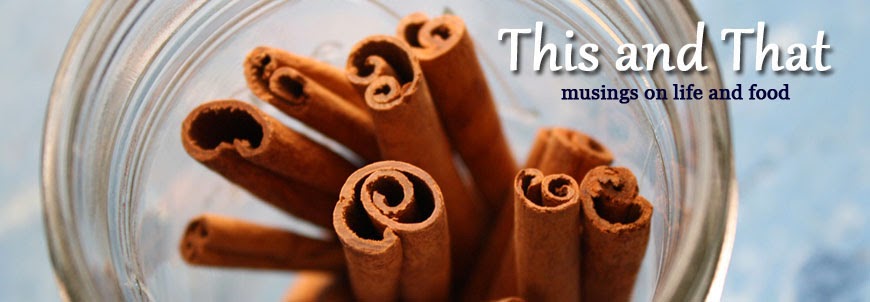I'd had Peruvian food only once before that I can recall: in a restaurant in Washington D.C. while on vacation a couple of years ago. I absolutely loved it, so was delighted to find multiple Peruvian recipes in Global Kitchen: The World's Most Delicious Food Made Easy, which my parents gave me for Christmas.
This meal introduced me to a new ingredient--aji amarillo paste--which I thankfully found on Amazon. It's made from a medium-hot yellow chili pepper which is very common in Peru. When I tasted the paste on its own, I worried that the dishes using it would be too hot for my taste, but that wasn't the case at all. It brought a nice flavor and a bit of heat, but nothing on my plate felt too spicy. Here's a rundown of our menu!
Peruvian Beef Kebabs (Anticuchos with Roasted Yellow Pepper Sauce) - These beef kebabs are marinated in red wine vinegar, aji amarillo, cumin, and turmeric. Then you dust them with parsley and more of the same spices, grill them (or cook in a cast iron skillet like I did), and dip them in this beautiful sauce made from roasted yellow bell pepper, green onions, white vinegar, oil, lemon, cumin, aji amarillo, turmeric, and garlic. This recipe actually calls for ground aji amarillo; since I bought paste instead of powder, I simply used the aji amarillo paste in the marinade and sauce. For the spice rub, I subbed equal parts regular paprika and smoked paprika. This was my favorite dish of the night.
Potatoes with Huancaina Sauce (Papa a la Huancaina) - This dish was the most unlike anything I've ever had before. To serve, you cover a platter with a bed of shredded lettuce, then top with boiled, peeled potatoes (gold or blue), and drizzle with a sauce made from roasted red bell pepper, sauteed onion and garlic, evaporated milk, aji amarillo paste, queso fresco (cheese), olive oil, and salt. But wait--there's more. On top of that you arrange wedges of hard-boiled eggs and a sprinkling of black olives. Potatoes are big in Peruvian cuisine, and this particular dish comes from the Peruvian highlands (Huancayo). I couldn't find the exact recipe I used online, but this one is fairly close to what I cooked from Global Kitchen.
Peruvian Sarsa Salad - My guests and I couldn't decide whether this was supposed to be a side dish eaten separately, or a relish eaten with a meaty main dish. Fortunately, it seemed to work both ways. It added a bright, fresh, crisp element to our plates. It was made from red onions, radishes, lima beans, queso fresco, roasted red bell pepper, and fresh cilantro and mint, all tossed in a light dressing of fresh lemon juice, olive oil, garlic, salt, and pepper. I was worried that it would be overpoweringly oniony, but it actually was really nicely balanced and lovely. I used extra lima beans in place of hominy, queso fresco instead of feta or farmer's cheese, and some red bell pepper I roasted myself instead of using bottled.
Crema Volteada - For dessert, I made this Peruvian flan. I found several variations online (surprise, surprise), including one that incorporated pureed cooked quinoa, which sounded intriguing. I landed on this one which seemed more basic. For me, it was the weakest link in the menu--the texture was a little off (probably my doing), and it was the least adventurous element since I've had flan plenty of times before. However, in terms of work and time management, it was perfect--it could be made the day before, which was especially nice since there were so many different elements to prepare in the other dishes.


